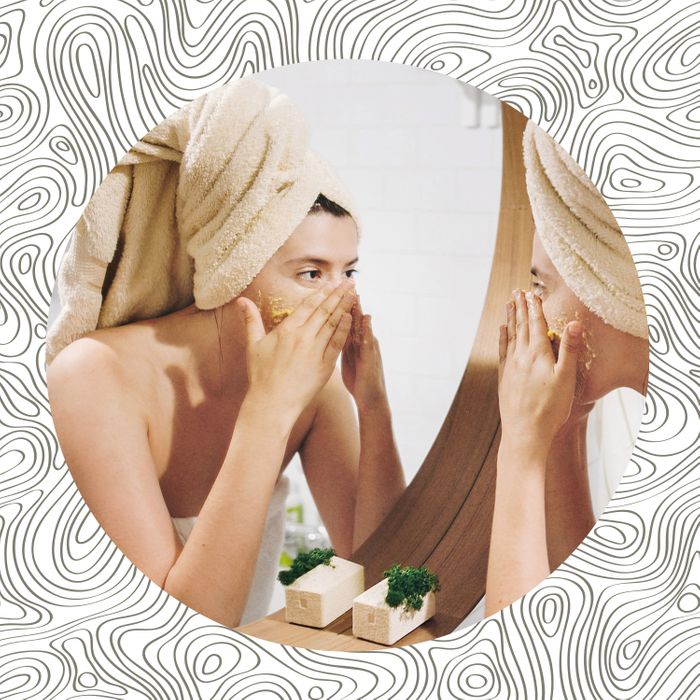
The bar for glowing, gleaming skin has reached literally inhuman levels — goals include looking like a glazed donut, a dolphin, or a dewy dumpling, depending on whom you ask. No matter what you’re going for, exfoliation (the process of sloughing away dead skin cells) definitely helps get you there. However, there can be too much of a good thing, and if you’re too aggressive with exfoliating, you can damage your skin and cause mild to severe irritation. How do you walk the line?
“I’m seeing many people coming into my clinic with serious irritation because they can’t tolerate all these products that they’re trying,” says dermatologist Dr. Corey L. Hartman, the founder and medical director of Skin Wellness Dermatology. “I think it’s a by-product of the year we’ve had, where people have gotten really into skin care, but the amount of exfoliation I’m seeing is way too much.”
A quick primer on the two main kinds of exfoliating: First, there’s chemical exfoliants, which use gentle acids to melt away dead skin without a lot of scrubbing on your part. Then there are physical exfoliants, which use tiny particles like seeds or fruit kernels to remove the dead skin when you rub them around. Both can work, but should be used in small doses.
According to Dr. Hartman, many people make the mistake of combining too many exfoliating ingredients or steps in their routine. One example is mixing retinoids (a type of chemical exfoliant) with other exfoliating ingredients, like scrubs. Another is using chemically exfoliating products too frequently, stripping the skin of its natural barrier and not allowing it time to recover.
Retinoids, which are vitamin A derivatives, are considered the gold standard for both anti-acne and anti-aging processes — but most people don’t realize that they have exfoliating properties, too. “Retinoids definitely exfoliate,” confirms Dr. Hartman. “Oftentimes, people will use a nightly retinoid but also use a mechanical cleansing brush and an exfoliating cleanser and perhaps even some kind of peel product as well. That is far too much.”
If you are already using a retinoid and want to introduce any other exfoliating product into your routine, Dr. Hartman recommends doing so carefully and gradually. “I would suggest using something that has glycolic acid, which is an alpha-hydroxy acid. It’s humectant, so it actually helps attract water to the skin, which makes it a little easier to tolerate,” he says. Even then, he advises not to use it more than a couple of times a week, especially at first.
Even if you don’t use a retinoid (despite their efficacy, there’s plenty of reasons you may not — higher concentrations of them can be hard for the skin to tolerate, and they’re not recommended if you’re pregnant or breastfeeding), you still should be gentle. “Again, if you’re using a mechanical cleansing brush or you’re having treatments in a doctor’s office like microdermabrasion, you need to reduce your use of other exfoliants,” he cautions.
It’s impossible to talk about exfoliating without touching on a common point of contention: physical exfoliants like scrubs. Critics say they’re too aggressive and claim that the exfoliating particles cause inflammation and/or minuscule tears in the skin. According to Dr. Hartman, some of these claims are true — but not all. “I’m not totally against scrubs,” he says. “I certainly don’t recommend all of them, and some of them can be very harsh.” The trick is to see how your skin reacts — if you have a scrub in your routine that you like and doesn’t cause irritation, there’s no need to stop using it. But if your skin stings, turns red, gets itchy, or otherwise seems upset by whatever you’ve done to it, that’s a sign to try something else.
Another contentious product in the exfoliating realm is Biologique Recherche P50 Lotion, a chemical exfoliant that costs a lot (nearly $150), smells foul, and has a cult-like following who call it “Jesus in a bottle.” Naturally, there are equally vocal detractors who say it’s way too strong, stinky, and overpriced, but Dr. Hartman is a fan. “There’s no denying it smells awful, but it’s worth the odor and the price tag. It keeps your skin hydrated and moisturized while making it really bright.”
Ultimately, getting into that sweet spot is all about balance. You naturally shed dead skin all the time — you get a new top layer of skin every two to three weeks. But makeup, sunscreen, or even just sweat can slow down that process, so exfoliating is helpful. “Otherwise, you have dead skin hanging out and encouraging buildup, which can lead to breakouts,” says Dr. Hartman. “You want to be right on that line of exfoliating enough to promote cell turnover but not so much that you’re causing irritation.”
And if you have gone too far? No biggie. Just stop using any exfoliants, physical or chemical, for at least a few weeks to give your skin time to rebuild its natural barrier. Then, proceed with a lighter touch.
"much" - Google News
June 22, 2021 at 12:22AM
https://ift.tt/3cZK5Oz
How Much Exfoliating Is Too Much? - The Cut
"much" - Google News
https://ift.tt/37eLLij
Shoes Man Tutorial
Pos News Update
Meme Update
Korean Entertainment News
Japan News Update
Bagikan Berita Ini















0 Response to "How Much Exfoliating Is Too Much? - The Cut"
Post a Comment